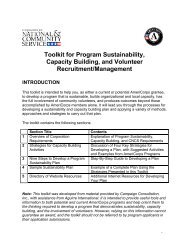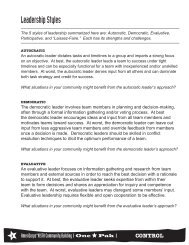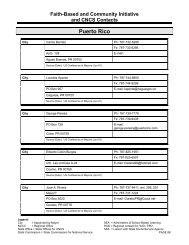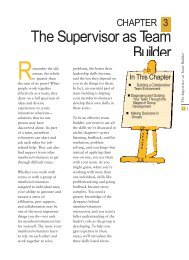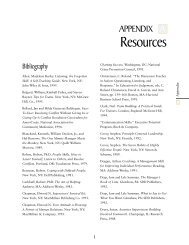MAKE IT LAST FOREVER: THE ... - National Service Resource Center
MAKE IT LAST FOREVER: THE ... - National Service Resource Center
MAKE IT LAST FOREVER: THE ... - National Service Resource Center
You also want an ePaper? Increase the reach of your titles
YUMPU automatically turns print PDFs into web optimized ePapers that Google loves.
CURRICULAR<br />
INTEGRATION:<br />
SCHOOL<br />
DISTRICT<br />
STATE<br />
FUNCTION 1: POWER<br />
CAPAC<strong>IT</strong>Y- WIDESPREAD USE SYSTEMIC<br />
BUILDING & SUPPORT INTEGRATION<br />
A few teachers are beginning to<br />
link service to academic subjects<br />
but service may still be in the<br />
form of required and<br />
unsupervised hours. Minimal<br />
reflective activities occur or count<br />
as part of the class grade.<br />
Few opportunities for students to<br />
engage in service learning are<br />
available. Model projects,<br />
curricula, or planning guides are<br />
not available. <strong>Service</strong> may be a<br />
component of an extracurricular<br />
club or program. The district does<br />
not endorse service learning in<br />
any way.<br />
<strong>Service</strong> learning is not included as<br />
a component of curricular<br />
frameworks. SDE personnel are<br />
not interested in or aware of how<br />
to assist districts in infusing the<br />
pedagogy.<br />
Many teachers make service a<br />
component of some subjects and<br />
school day activities. Assignments<br />
are sometimes interdisciplinary, and<br />
are based on required competencies,<br />
and demonstrate understanding of<br />
content areas.<br />
A service learning course may exist<br />
at the local high school. Some<br />
model projects and curricula exist,<br />
but only a few teachers and schools<br />
are using service learning. <strong>Service</strong> is<br />
performed by several extracurricular<br />
clubs and certain populations as part<br />
of the curriculum (e.g., special<br />
education or gifted). The district is<br />
quietly supportive of service<br />
learning.<br />
<strong>Service</strong> learning is considered a part<br />
of the civics or citizenship<br />
dimensions of curricula, and the<br />
SDE may develop suggestions for<br />
how schools and districts can<br />
incorporate service into this subject<br />
area.<br />
STAGES OF INST<strong>IT</strong>UTIONALIZATION<br />
75<br />
Most or all teachers infuse service into<br />
all academic areas in an interdisciplinary<br />
way, and regularly use school time for<br />
activities. Students, teachers, parents,<br />
and administrators all understand how<br />
the service connects to academic<br />
learning, and service is seen as a most<br />
effective pedagogy.<br />
<strong>Service</strong> learning is available in most or<br />
all academic subjects K-12. Curricular<br />
guides and interdisciplinary curricula are<br />
widely available and utilized. <strong>Service</strong> is<br />
a teaching method used by faculty to<br />
teach required material to all<br />
populations. The district highlights<br />
service as an important pedagogical<br />
approach to educators, parents, and the<br />
community.<br />
<strong>Service</strong> learning is officially linked to all<br />
academic areas, and the SDE develops<br />
planning guides, highlights curricula,<br />
and hosts occasions through which<br />
districts can examine the ways in which<br />
service is linked to curricula.



